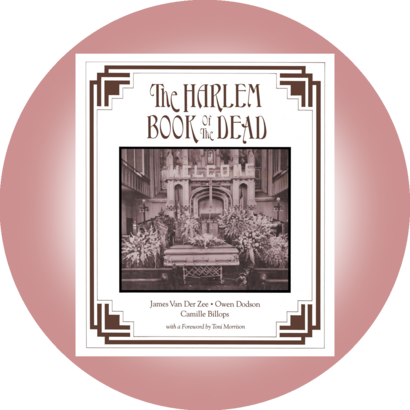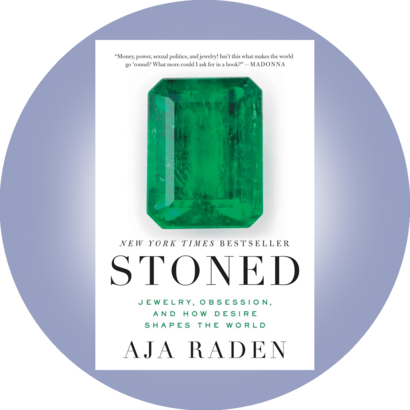Rosalía’s first offering from her upcoming Lux album (out November 7) is her most experimental yet. She sings opera in German, later ruefully in Spanish. The lyrics, threaded between urgent strings and chanting, all reference her heavy heart: His fear is my fear / His anger is my anger / His love is my love / His blood is my blood. The song features Icelandic singer Björk—whose verse is redolent of the tunes on her 2015 divorce album, Vulnicura—and the American singer Yves Tumor, whose filtered voice begs at the end, “I’ll fuck you till you love me.” Dance is the divinity these artists find to vivify them, taking inspiration from the Berlin techno club Berghain—this single’s namesake—and lifting it to operatic, sacred heights. Rosalía leaves behind the distorted heavy beats of her 2022 album, Motomami, and instead sends the listener into an urgent collage of melody and need, like a prayer. (spotify.com) —Andie Blaine

read
The Harlem Book of the Dead
Black funerals in New York City were once a celebration, welcoming the deceased into an afterlife of peace after a lifetime of struggle. The practice is revived in the re-release of The Harlem Book of the Dead, originally published in 1978. The book comprises over three dozen portraits by photographer James Van Der Zee—a renowned figure of the Harlem Renaissance known for depicting Black middle-class life—that offer a visual chronology of the tradition, complete with biblical and mythical adornments. With a foreword by Toni Morrison, the book immortalizes a forgotten cultural touchstone and is a perfect read for this haunted weekend. ($24, primaryinformation.org) —Maggie Turner

sleep
Ostermoor
Getting a set of Matouk sheets is always a thrill, but new duvets are rarely a reason to celebrate. Enter Ostermoor, whose handmade mattresses first debuted in New York’s Nolita neighborhood in 1853. (Enthusiasm for them continues in sleep-obsessed circles even today.) There’s nothing newfangled or plasticky about their products, which is exactly why we’re drawn to them. The hefty down duvet is almost as comforting as a weighted blanket, but sufficiently light and breathable so those who run hot don’t feel suffocated. It’s the result of a carefully calibrated combination of 80 percent duck down and 20 percent feathers, ensconced in durable, 100 percent japara cotton that has been sewn into squares so that the filling stays evenly distributed. It’s not magic, but somehow the result feels that way. ($575, ostermoor.com) —Ashley Baker

strut
Herbert Levine
Spare yourself the mirthless drudgery of scouring Amazon for a last-minute costume and opt for what the British call “fancy dress,” which will long outlast the spooky season. The masterful shoemakers at Herbert Levine, founded in 1948 and recently revived under the creative aegis of Trevor Houston, have something for every kind of trick-or-treater. The two-faced boot in pony hair looks tailor-made for Cruella de Vil, and the Raincheck kitten heel makes for a perfect Cinderella glass slipper—or a fitting accessory to Patrick Bateman’s blood-covered raincoat. The devil and The Wizard of Oz’s Dorothy could have their pick of ruby-red heels: the Sitting Pretty, the Not Half Bad, and the Apéritif all fit the bill. (from $860, herbertlevine.com) —Victoria Herman

read
Motherland
People may get the government they deserve, but Russian women don’t. The Bolsheviks’ promise of equality broke down quickly: in her new book, Motherland, Julia Ioffe chronicles how Soviet women could become doctors and scientists but still had to shop, cook, raise the children, and mop the floors. Ioffe, whose family immigrated to the United States in 1990, when she was seven, returned as a reporter in 2009. She discovered that capitalism had made Russian society worse: In the post-Soviet free-for-all, talented young women narrowed their ambitions to snagging a rich man—Slavic Stepford wives, if you will. Motherland combines history with family memoir, offering a fresh female view of Russia’s path to neo-Soviet autocracy under Putin. ($35, amazon.com) —Alessandra Stanley

look
Stoned
As an art-and-jewelry historian, I consider last week’s Louvre heist to be my Watergate, which has led me to revisit the 2015 book by Aja Raden, Stoned—in which she surveys a complex history of loots and scandals around four pieces of jewelry. From Marie Antoinette’s 2,800-karat diamond necklace being tinder to the fire of revolution to a ceremonial Colombian emerald being stolen by conquistadors, Raden reminds readers that greed and patriotism are always central themes when it comes to gemstones. Jewelry has and will continue to be an object of obsession, good and bad, broken down, resold, and turned into something new. ($18.99, amazon.com) —Gracie Wiener

